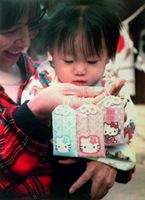|
Top Picks || Arts & Entertainment || Business & Economy || Education & Society ||
CUTENESS CRAZE: A Little White Kitten Captures Japan's Heart August 24, 1998  Hello Kitty products are loved by children, but adults are just as likely to snap them up. (Jiji Press) The image of "Hello Kitty," a white kitten whose trademark is a flower or red bow attached to her left ear, is popping up all over Japan--and not just on children's bags. Kitty goods have taken the form of everything from household items, like rice cookers and telephones, to office computers and even automobiles. The popularity of characters including Snoopy and Doraemon have also penetrated adult society, giving birth to a booming market for products that carry these images. The verdict is still out, however, on whether businessmen who wear Snoopy neckties to meetings are fashionable trend setters or simply childish adults. Boosting Japan's Depressed Consumer Market In the midst of Japan's consumer lull, many industries are jumping on the Kitty bandwagon. In 1997 a major electronics company introduced household items such as rice cookers, toasters, hair dryers, irons, and televisions featuring Hello Kitty. The character can also be found on golf-related items like bags and golf club headcovers. In 1998 the Kitty boom expanded to include pricier items, such as a 50-cc motor scooter and even a compact car emblazoned with the Kitty image. Characters Serve as College Guides The academic world is also enlisting the services of popular characters. Animation heroes from the Finnish "Moomin" books and the Japanese cartoon "Cyborg 009" have begun appearing in the pamphlets of several private universities. These schools hope that images of these characters will help arouse the interest of prospective freshmen. Characters are a Child's Best Friend A psychiatrist adds, "Children view fictional characters as imaginary friends who serve as a reliable source of support when they enter kindergarten and first begin interacting with others. The continued attachment of adults to these characters, even into their twenties and thirties, is a reflection of the uncertainty of today's social environment."
 Edited
by Japan Echo Inc. based on domestic Japanese news sources.
Articles presented here are offered for reference purposes and do not
necessarily represent the policy or views of the Japanese Government. Edited
by Japan Echo Inc. based on domestic Japanese news sources.
Articles presented here are offered for reference purposes and do not
necessarily represent the policy or views of the Japanese Government.
|
